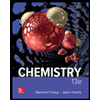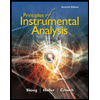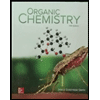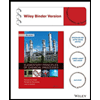
Connect 1-Semester Access Card for General, Organic, and Biochemistry
9th Edition
ISBN: 9781259815096
Author: Katherine J Denniston, Joseph J Topping, Dr Danae Quirk Dorr
Publisher: McGraw-Hill Education
expand_more
expand_more
format_list_bulleted
Concept explainers
Question
Chapter 4.1, Problem 4.3PP
Interpretation Introduction
Interpretation:
The number of moles of sodium that are represented by
Expert Solution & Answer
Want to see the full answer?
Check out a sample textbook solution
Students have asked these similar questions
Draw the product of the reaction shown below.
Ignore inorganic byproducts.
cat. H2SO4
HNO3 (1 equiv)
Drawing
Q
Provide the correct systematic name for the compound shown here.
Using the appropriate bond energies, calculate the heat of reaction AH for the following reaction:
H-H + CI-CI
2 H-CI
You can find a table of bond energies by using the Data button on the ALEKS toolbar.
Round your answer to the nearest kJ/mol.
Note: For clarity, all lone pairs have been omitted from the molecular structures.
☐
kJ
mol
ค
000
Ar
B
Chapter 4 Solutions
Connect 1-Semester Access Card for General, Organic, and Biochemistry
Ch. 4.1 - Calculate the mass, in g, of Avogadro’s number...Ch. 4.1 - Prob. 4.2PPCh. 4.1 - Prob. 4.3PPCh. 4.1 - What is the mass, in g, of 3.50 mol of the element...Ch. 4.1 - Calculate the number of mol of silver in a silver...Ch. 4.1 - Prob. 4.6PPCh. 4.1 - Prob. 4.1QCh. 4.1 - Prob. 4.2QCh. 4.2 - Prob. 4.7PPCh. 4.2 - Prob. 4.8PP
Ch. 4.2 - Prob. 4.3QCh. 4.2 - Prob. 4.4QCh. 4.3 - Prob. 4.5QCh. 4.3 - Prob. 4.6QCh. 4.4 - Prob. 4.9PPCh. 4.4 - Prob. 4.10PPCh. 4.5 - Prob. 4.11PPCh. 4.6 - Prob. 4.12PPCh. 4.6 - Prob. 4.7QCh. 4.6 - Prob. 4.8QCh. 4.8 - Prob. 4.9QCh. 4.8 - Prob. 4.10QCh. 4.8 - Prob. 4.11QCh. 4.8 - Prob. 4.12QCh. 4.8 - Chrome plating involves the reduction of Cr3+(aq)...Ch. 4.8 - Prob. 4.14QCh. 4.9 - Prob. 4.13PPCh. 4.9 - When potassium cyanide (KCN) reacts with...Ch. 4.9 - Prob. 4.15PPCh. 4.9 - Prob. 4.16PPCh. 4.9 - Prob. 4.17PPCh. 4.9 - Barium carbonate decomposes upon heating to barium...Ch. 4.9 - Prob. 4.19PPCh. 4.9 - Prob. 4.15QCh. 4.9 - Prob. 4.16QCh. 4 - Prob. 4.17QPCh. 4 - What is the average mass (in amu) of:
Zr
Cs
Ca
Ch. 4 - What is the average molar mass of:
Si
Ag
As
Ch. 4 - What is the average molar mass of:
S
Na
Hg
Ch. 4 - What is the mass, in g, of Avogadro’s number of...Ch. 4 - What is the mass, in g, of Avogadro’s number of...Ch. 4 - How many carbon atoms are present in 1.0 × 10−4...Ch. 4 - How many mercury atoms are present in 1.0 × 10−10...Ch. 4 - How many mol of arsenic correspond to 1.0 × 102...Ch. 4 - How many mol of sodium correspond to 1.0 × 1015...Ch. 4 - How many g of neon are contained in 2.00 mol of...Ch. 4 - How many g of carbon are contained in 3.00 mol of...Ch. 4 - What is the mass, in g, of 1.00 mol of helium...Ch. 4 - What is the mass, in g, of 1.00 mol of nitrogen...Ch. 4 - Calculate the number of mol corresponding to:
20.0...Ch. 4 - Calculate the number of mol corresponding to:
0.10...Ch. 4 - What is the mass, in g, of 15.0 mol of silver?
Ch. 4 - What is the mass, in g, of 15.0 mol of carbon?
Ch. 4 - Calculate the number of silver atoms in 15.0 g of...Ch. 4 - Calculate the number of carbon atoms in 15.0 g of...Ch. 4 - Prob. 4.37QPCh. 4 - Distinguish between the terms formula mass and...Ch. 4 - Calculate formula mass and the molar mass of each...Ch. 4 - Calculate formula mass and the molar mass of each...Ch. 4 - Calculate formula mass and the molar mass of...Ch. 4 - Calculate formula mass and the molar mass of...Ch. 4 - Calculate formula mass and the molar mass of CuSO4...Ch. 4 - Calculate formula mass and the molar mass of CaCl2...Ch. 4 - Calculate the number of mol corresponding to:
15.0...Ch. 4 - Calculate the number of mol corresponding to:
15.0...Ch. 4 - Calculate the mass in g corresponding to:
1.000...Ch. 4 - Calculate the mass in g corresponding to:
0.400...Ch. 4 - How many g are required to have 0.100 mol of each...Ch. 4 - Prob. 4.50QPCh. 4 - How many mol are in 50.0 g of each of the...Ch. 4 - How many mol are in 50.0 g of each of the...Ch. 4 - What law is the ultimate basis for a balanced...Ch. 4 - List the general types of information that a...Ch. 4 - Prob. 4.55QPCh. 4 - Prob. 4.56QPCh. 4 - Prob. 4.57QPCh. 4 - What is the meaning of (s), (l), (g), and (aq)...Ch. 4 - Prob. 4.59QPCh. 4 - Prob. 4.60QPCh. 4 - What is the meaning of the subscript in a chemical...Ch. 4 - What is the meaning of the coefficient in a...Ch. 4 - When you are balancing an equation, why must the...Ch. 4 - Describe the process of checking to ensure that an...Ch. 4 - Prob. 4.65QPCh. 4 - Prob. 4.66QPCh. 4 - Prob. 4.67QPCh. 4 - Prob. 4.68QPCh. 4 - Prob. 4.69QPCh. 4 - Balance each of the following equations:
Ch. 4 - Write a balanced equation for each of the...Ch. 4 - Prob. 4.72QPCh. 4 - 4.67 Which of the following ionic compounds will...Ch. 4 - Prob. 4.74QPCh. 4 - Will a precipitate form if solutions of the...Ch. 4 - Prob. 4.76QPCh. 4 - Solutions containing (NH4)2CO3(aq) and CaCl2(aq)...Ch. 4 - Prob. 4.78QPCh. 4 - Describe the difference between the terms ionic...Ch. 4 - Prob. 4.80QPCh. 4 - Write the net ionic equation for the reaction of...Ch. 4 - Prob. 4.82QPCh. 4 - Does an acid gain or lose a hydrogen cation, H+,...Ch. 4 - Prob. 4.84QPCh. 4 - Identify the acid and base in the following...Ch. 4 - Prob. 4.86QPCh. 4 - Prob. 4.87QPCh. 4 - Prob. 4.88QPCh. 4 - Prob. 4.89QPCh. 4 - Prob. 4.90QPCh. 4 - In the following reaction, identify the oxidized...Ch. 4 - Prob. 4.92QPCh. 4 - Prob. 4.93QPCh. 4 - Prob. 4.94QPCh. 4 - Prob. 4.95QPCh. 4 - Prob. 4.96QPCh. 4 - Prob. 4.97QPCh. 4 - Prob. 4.98QPCh. 4 - Why is it essential to use balanced equations to...Ch. 4 - Describe the steps used in the calculation of g of...Ch. 4 - How many g of B2H6 will react with 3.00 mol of...Ch. 4 - How many g of Al will react with 3.00 mol of O2?
Ch. 4 - Calculate the number of moles of CrCl3 that could...Ch. 4 - A 3.5-g sample of water reacts with PCl3 according...Ch. 4 - Prob. 4.105QPCh. 4 - Prob. 4.106QPCh. 4 - Prob. 4.107QPCh. 4 - Triglycerides (Chapters 17 and 23) are used in...Ch. 4 - Joseph Priestley discovered oxygen in the...Ch. 4 - Dinitrogen monoxide (also known as nitrous oxide...Ch. 4 - The burning of acetylene (C2H2) in oxygen is the...Ch. 4 - Prob. 4.112QPCh. 4 - Various members of a class of compounds called...Ch. 4 - Prob. 4.114QPCh. 4 - A rocket can be powered by the reaction between...Ch. 4 - A 4.00-g sample of Fe3O4 reacts with O2 to produce...Ch. 4 - If the actual yield of decane in Question 4.99 is...Ch. 4 - If the actual yield of oxygen gas in Question...Ch. 4 - If the % yield of nitrogen gas in Question 4.101...Ch. 4 - If the % yield of Fe2O3 in Question 4.102 is...Ch. 4 - Prob. 1CPCh. 4 - Prob. 2CPCh. 4 - Prob. 3CPCh. 4 - Prob. 4CPCh. 4 - Prob. 5CP
Knowledge Booster
Learn more about
Need a deep-dive on the concept behind this application? Look no further. Learn more about this topic, chemistry and related others by exploring similar questions and additional content below.Similar questions
- Predict the hydrocarbon, of formula C6H10, needed to prepare the following geminal dibromide upon treatment with excess hydrobromic acid. Note: The shown product is the only regioisomer formed in this reaction. HBr H₂C. CH3arrow_forwarddraw the major product formed with the listed reagentsarrow_forwardPropose Williamson ether syntheses for the following compoundsarrow_forward
- Identify all functional groupsarrow_forwardA mixture of CaCO3 and MgC2O4 of unknown mass was heated in a 0.5 L closed rigid vessel to 900 degrees C.at 400C the following reaction occurs:MgC2O4 -> MgO (s) + CO (g) + CO2 (g)At 700C a second reaction occurs: CaCO3 -> CaO (s) + CO2 (g)The solid mass in the vessel was measured to be 3.06 g at 400C and 2.03g at 900CQuestion: What is the partial pressure of CO in both temperatures? (400 and 900C), provide detailed explanation.arrow_forwardFor the following alkyne, complete the reaction sequentially (that is draw the intermediate that we can’t stop at) and then name (complete name) all 3 molecules.arrow_forward
- Given the reaction sequence below, answer the following. A. Provide the structure for A. B. Provide the structure for B (pay attention to stereochemistry). C. Provide the structure for C. D. What are the stereochemical designations for I and II (R/S)?arrow_forwardWhich of the following is the most stable carbon radical?arrow_forwardPut the following carbon radicals in order of increasing stability.arrow_forward
- Draw the major organic product for each of the following reactions (pay attention to stereochemistry).arrow_forwardThere are 2 reactions (that you know of) to achieve the following transformation: One reaction is favored over the other because it avoids a competing reaction. A. Draw the favored reaction scheme (not the mechanism), be sure to include all necessary reagents. B. Draw the reaction scheme that is not favored and include all the possible products.arrow_forwardBoth carbocations and carbon-radicals have trigonal planar geometry. True or Falsearrow_forward
arrow_back_ios
SEE MORE QUESTIONS
arrow_forward_ios
Recommended textbooks for you
 ChemistryChemistryISBN:9781305957404Author:Steven S. Zumdahl, Susan A. Zumdahl, Donald J. DeCostePublisher:Cengage Learning
ChemistryChemistryISBN:9781305957404Author:Steven S. Zumdahl, Susan A. Zumdahl, Donald J. DeCostePublisher:Cengage Learning ChemistryChemistryISBN:9781259911156Author:Raymond Chang Dr., Jason Overby ProfessorPublisher:McGraw-Hill Education
ChemistryChemistryISBN:9781259911156Author:Raymond Chang Dr., Jason Overby ProfessorPublisher:McGraw-Hill Education Principles of Instrumental AnalysisChemistryISBN:9781305577213Author:Douglas A. Skoog, F. James Holler, Stanley R. CrouchPublisher:Cengage Learning
Principles of Instrumental AnalysisChemistryISBN:9781305577213Author:Douglas A. Skoog, F. James Holler, Stanley R. CrouchPublisher:Cengage Learning Organic ChemistryChemistryISBN:9780078021558Author:Janice Gorzynski Smith Dr.Publisher:McGraw-Hill Education
Organic ChemistryChemistryISBN:9780078021558Author:Janice Gorzynski Smith Dr.Publisher:McGraw-Hill Education Chemistry: Principles and ReactionsChemistryISBN:9781305079373Author:William L. Masterton, Cecile N. HurleyPublisher:Cengage Learning
Chemistry: Principles and ReactionsChemistryISBN:9781305079373Author:William L. Masterton, Cecile N. HurleyPublisher:Cengage Learning Elementary Principles of Chemical Processes, Bind...ChemistryISBN:9781118431221Author:Richard M. Felder, Ronald W. Rousseau, Lisa G. BullardPublisher:WILEY
Elementary Principles of Chemical Processes, Bind...ChemistryISBN:9781118431221Author:Richard M. Felder, Ronald W. Rousseau, Lisa G. BullardPublisher:WILEY

Chemistry
Chemistry
ISBN:9781305957404
Author:Steven S. Zumdahl, Susan A. Zumdahl, Donald J. DeCoste
Publisher:Cengage Learning

Chemistry
Chemistry
ISBN:9781259911156
Author:Raymond Chang Dr., Jason Overby Professor
Publisher:McGraw-Hill Education

Principles of Instrumental Analysis
Chemistry
ISBN:9781305577213
Author:Douglas A. Skoog, F. James Holler, Stanley R. Crouch
Publisher:Cengage Learning

Organic Chemistry
Chemistry
ISBN:9780078021558
Author:Janice Gorzynski Smith Dr.
Publisher:McGraw-Hill Education

Chemistry: Principles and Reactions
Chemistry
ISBN:9781305079373
Author:William L. Masterton, Cecile N. Hurley
Publisher:Cengage Learning

Elementary Principles of Chemical Processes, Bind...
Chemistry
ISBN:9781118431221
Author:Richard M. Felder, Ronald W. Rousseau, Lisa G. Bullard
Publisher:WILEY
Step by Step Stoichiometry Practice Problems | How to Pass ChemistryMole Conversions Made Easy: How to Convert Between Grams and Moles; Author: Ketzbook;https://www.youtube.com/watch?v=b2raanVWU6c;License: Standard YouTube License, CC-BY